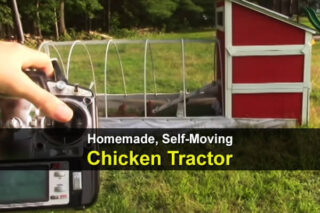Estimated reading time: 5 minutes
If you've been dreaming of eating freshly gathered eggs in the morning, you may be considering building a chicken coop in your backyard or on your homestead.
Designs and plans can vary widely for chicken coops, depending on what building materials you have on hand and how many chickens you want to raise. However, there are some basics every good coop needs.
First, select the site for your chicken coop. You will want a southern-facing location on higher ground that offers adequate drainage. Chickens can be noisy and smelly, so look for spots that won’t bother your family or your neighbors.
Healthy birds need plenty of room to move around. Local restrictions differ, but each bird requires three to five square feet of space. If they are to be inside the coop all day, plan on doubling that space. If you are including an outside run, allow at least 10 square feet for each bird.
Want to save this post for later? Click Here to Pin it On Pinterest!
Chickens are sensitive to cold and damp weather, so include plenty of ventilation in your plans, but make sure you offer your chickens adequate protection from cold drafts. Light stimulates egg production, so make use of natural lighting wherever possible, and you may want to consider installing electric lights for the winter.
Keep accessibility – both for your chickens and for you – uppermost in your mind when building your coop. You will need convenient access to various areas of the coop in order to keep them clean. Handy access doors and dropping trays can make clean up easy.
In addition to the lumber, roofing, windows, and hardware needed to build your structure, here is a basic shopping list for a chicken coop. We have included links to Amazon for pricing references when possible.
1. Roosts – Chickens have a natural roosting behavior, and they feel more at ease when they are perched. In fact, this is the position in which they sleep, and chickens sleep a lot! You will want to provide nine to 10 inches of perch space for each bird. You can use wooden rails or bars for their perches.
2. Nesting Boxes – Hens like to nest in boxes to help them feel safe and secure. Look for simple and easy to clean wooden boxes. A nesting box should be least four inches deep and large enough so that a hen can comfortably lay her eggs. Aim to have at least one nesting box for every three hens.
3. Nesting Pads – Nesting pads encourage hens to lay eggs inside the nesting box and also help provide a softer surface that helps protect eggs from breakage.
4. Waterers – There are many products on the market to use as waterers for your chickens. This two-gallon heavy-duty stand-alone waterer maintains a constant water level and can be paired with a heater base in the winter. Another plus is that its edges discourage roosting.
5. Feeders – You can allow chickens to eat on demand with certain feeders. With a 20-pound capacity, this feeder is designed to keep out rodents and other birds.
6. Dust Bath – Chickens like to give themselves dust baths. It is their way of keeping their feathers clean and free of parasites. If dry soil is not accessible to your chickens for this behavior, offer them a box or a hole filled with dust bath. The box or hole should be large enough for a chicken to lie down in and to be able to spread her wings in – usually about two feet by two feet.
7. Heating – To provide your birds with extra warmth in the winter, you might need a small heater. Some styles are safe and easy to use with no bulbs or lamps to replace.
8. Bedding – Line your coop with straw, wood chips, or shavings for bedding. Add more bedding material to keep your birds warm in the winter, and use less in the summer to protect your birds from overheating.
9. Shade – Make sure your chickens have a comfortable spot away from the heat of the sun. Use shade cloth or slanted roofing to offer your chickens a safe haven in the summer months.
10. Predator Protection – Careful attention to screening, windows, and doors will help keep your chickens safe from predators, including raccoons, coyote, foxes, birds of prey, and even neighborhood cats and dogs. Protect your chickens by using a sturdy wire mesh around the entire building and placing a padlock on the door if you have one.
Research the predators in your area and add extra deterrents as necessary. One option is to add a solar-powered light to scare away night-time predators.
Like this post? Don't Forget to Pin It On Pinterest!











Free range your birds and provide adequate supplemental nutrition (minimally damaged garden produce, dinner leftovers, etc.).
Give them a safe place to roost and good water.
Trouble is keeping them out of unwanted areas.
No need to buy all the sponsored items.
I agree with Marvin that store-bought bits really aren’t necessary.
A predator-proof place to live (coop, run). Food and water available. A variety of foods is good (free-range greens, bugs, kitchen scraps) but not absolutely necessary.
I’ve found that rule of roosting bar space inadequate for ‘peace and tranquility.’ What with the pecking order, some birds just won’t roost next to others. They can get mean about it. Provide some alternate spaces.
My experience is similar to Marvin’s. I’ve fenced my gardens to keep them from digging everything up. Sometimes they get obsessed about digging up a section of yard. Only some temporary fencing will stop them. Other than that, free-ranging around the property keeps them happy.
Hi, I read this with much interest and (also) to check out your promited links…it is very frustrating that, FOR ME, the link to a heater goes back to the dust bath everey time! Thanks for reading. Hope you can respond with the actual link.
Sorry about that, I accidentally put the wrong link there. It’s fixed now.
Flubenvet I have found, is replaced by two dog bowls say one metre apart containing boiled cooked rice. Into each bowl is a heaped dessert spoon of DE, this is Food Grade (Cheap, 500g on ebay). The DE, Diatomaceous Earth, is stirred well into each bowl of rice by using a fork. The Flubenvet advises treatment once a month. If a hen is inactive and has its tail down, or worse, then put one of the dog bowls close by it. The hens go mad for the rice. So far the Rice+ DE Method has always worked! On one occasion the poorly hen was splayed out and the others were walking all over it and ignoring its plight. The hens are kept well by use of this method and so are laying well. For four hens I use five handfuls of rice, total, when needed.